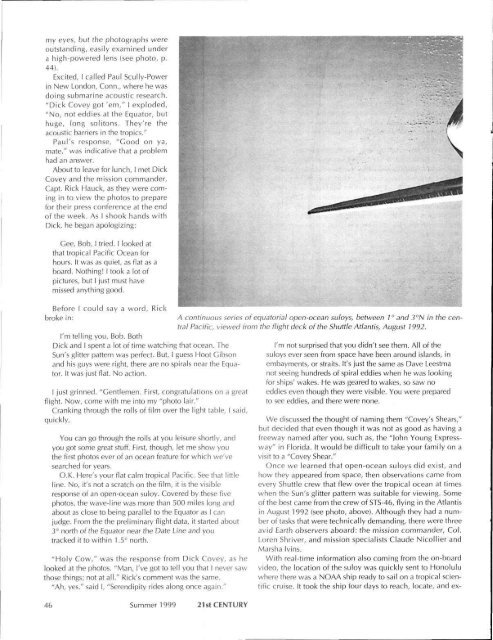Back to the Moon with Nuclear Rockets
Back to the Moon with Nuclear Rockets
Back to the Moon with Nuclear Rockets
- No tags were found...
You also want an ePaper? Increase the reach of your titles
YUMPU automatically turns print PDFs into web optimized ePapers that Google loves.
my eyes, but <strong>the</strong> pho<strong>to</strong>graphs wereoutstanding, easily examined undera high-powered lens (see pho<strong>to</strong>, p.44).Excited, I called Paul Scully-Powerin New London, Conn., where he wasdoing submarine acoustic research."Dick Covey got 'em," I exploded,"No, not eddies at <strong>the</strong> Equa<strong>to</strong>r, buthuge, long soli<strong>to</strong>ns. They're <strong>the</strong>acoustic barriers in <strong>the</strong> tropics."Paul's response, "Good on ya,mate," was indicative that a problemhad an answer.About <strong>to</strong> leave for lunch, I met DickCovey and <strong>the</strong> mission commander,Capt. Rick Hauck, as <strong>the</strong>y were comingin <strong>to</strong> view <strong>the</strong> pho<strong>to</strong>s <strong>to</strong> preparefor <strong>the</strong>ir press conference at <strong>the</strong> endof <strong>the</strong> week. As I shook hands <strong>with</strong>Dick, he began apologizing:Gee, Bob, I tried. I looked atthat tropical Pacific Ocean forhours. It was as quiet, as flat as aboard. Nothing! I <strong>to</strong>ok a lot ofpictures, but I just must havemissed anything good.Before I could say a word, Rickbroke in:I'm telling you, Bob. BothDick and I spent a lot of time watching that ocean. TheSun's glitter pattern was perfect. But, I guess Hoot Gibsonand his guys were right, <strong>the</strong>re are no spirals near <strong>the</strong> Equa<strong>to</strong>r.It was just flat. No action.I just grinned. "Gentlemen. First, congratulations on a greatflight. Now, come <strong>with</strong> me in<strong>to</strong> my "pho<strong>to</strong> lair."Cranking through <strong>the</strong> rolls of film over <strong>the</strong> light table, I said,quickly,You can go through <strong>the</strong> rolls at you leisure shortly, andyou got some great stuff. First, though, let me show you<strong>the</strong> first pho<strong>to</strong>s ever of an ocean feature for which we'vesearched for years.O.K. Here's your flat calm tropical Pacific. See that littleline. No, it's not a scratch on <strong>the</strong> film, it is <strong>the</strong> visibleresponse of an open-ocean suloy. Covered by <strong>the</strong>se fivepho<strong>to</strong>s, <strong>the</strong> wave-line was more than 500 miles long andabout as close <strong>to</strong> being parallel <strong>to</strong> <strong>the</strong> Equa<strong>to</strong>r as I canjudge. From <strong>the</strong> <strong>the</strong> preliminary flight data, it started about3° north of <strong>the</strong> Equa<strong>to</strong>r near <strong>the</strong> Date Line and youtracked it <strong>to</strong> <strong>with</strong>in 1.5° north."Holy Cow," was <strong>the</strong> response from Dick Covey, as helooked at <strong>the</strong> pho<strong>to</strong>s. "Man, I've got <strong>to</strong> tell you that I never sawthose things; not at all." Rick's comment was <strong>the</strong> same."Ah, yes." said I, "Serendipity rides along once again."4 b Summer 1999 21st CENTURYA continuous series of equa<strong>to</strong>rial open-ocean suloys, between 1° and 3°N in <strong>the</strong> centralPacific, viewed from <strong>the</strong> flight deck of <strong>the</strong> Shuttle Atlantis, August 1992.I'm not surprised that you didn't see <strong>the</strong>m. All of <strong>the</strong>suloys ever seen from space have been around islands, inembayments, or straits. It's just <strong>the</strong> same as Dave Leestmanot seeing hundreds of spiral eddies when he was lookingfor ships' wakes. He was geared <strong>to</strong> wakes, so saw noeddies even though <strong>the</strong>y were visible. You were prepared<strong>to</strong> see eddies, and <strong>the</strong>re were none.We discussed <strong>the</strong> thought of naming <strong>the</strong>m "Covey's Shears,"but decided that even though it was not as good as having afreeway named after you, such as, <strong>the</strong> "John Young Expressway"in Florida. It would be difficult <strong>to</strong> take your family on avisit <strong>to</strong> a "Covey Shear."Once we learned that open-ocean suloys did exist, andhow <strong>the</strong>y appeared from space, <strong>the</strong>n observations came fromevery Shuttle crew that flew over <strong>the</strong> tropical ocean at timeswhen <strong>the</strong> Sun's glitter pattern was suitable for viewing. Someof <strong>the</strong> best came from <strong>the</strong> crew of STS-46, flying in <strong>the</strong> Atlantisin August 1992 (see pho<strong>to</strong>, above). Although <strong>the</strong>y had a numberof tasks that were technically demanding, <strong>the</strong>re were threeavid Earth observers aboard: <strong>the</strong> mission commander, Col.Loren Shriver, and mission specialists Claude Nicollier andMarsha Ivins.With real-time information also coming from <strong>the</strong> on-boardvideo, <strong>the</strong> location of <strong>the</strong> suloy was quickly sent <strong>to</strong> Honoluluwhere <strong>the</strong>re was a NOAA ship ready <strong>to</strong> sail on a tropical scientificcruise. It <strong>to</strong>ok <strong>the</strong> ship four days <strong>to</strong> reach, locate, and ex-
















